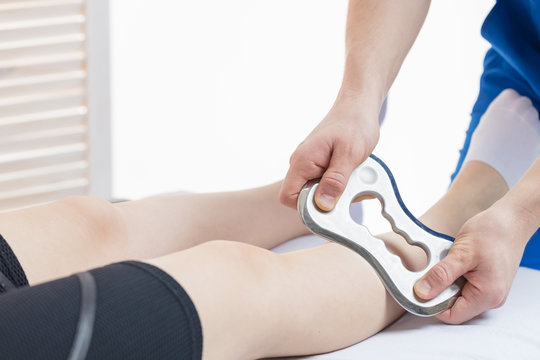
There are several types of soft tissue in the human body that support joint function, including fascia, muscles, tendons, and ligaments. Traumatic injury can shorten soft tissues, affecting a joint’s natural function and range of movement. Inflammation – secondary to trauma or injury – thickens soft tissue, which impacts joint function as well.
Soft tissue mobilization is a therapy to help reduce pain, relax muscles, improve range of motion, and restores strength. Additionally, it is used to break down soft tissue adhesions, which can form as a result of immobilization, repetitive strain, trauma, or surgery.
Physical therapists use this process to allow a joint to move naturally, stretching the soft tissues, relaxing muscles, and enhancing blood circulation. This movement is then gradually intensified until the deep tissue is reached and adhesions are released.
How does it work?
Physiotherapists use certain Instruments to effectively break down adhesions, scar tissue, and fascial restrictions. These instruments have been designed ergonomically so that the therapist can locate restrictions and treat affected areas.
Microtrauma introduced into soft tissue structures causes a local inflammatory response. It further initiates reabsorption of excessive scar tissue or inappropriate fibrosis and stimulates the natural healing process – leading to the remodeling of affected soft tissues. Soft tissue adhesions that have developed from immobilization, repeated strains, surgery, or other mechanisms are broken down, enabling full functional restoration of the soft tissue structures.
What types of injury are treated with mobilization therapy?

Mobilization therapy is used to treat problems affecting your upper and lower extremities, as well as neck, shoulder, and back pain. The common conditions in upper extremities that mobilization therapy can help with include;
- Golf elbow
- Carpal tunnel syndrome
- Tennis elbow
- A contracture
- Tendinitis of your biceps or rotator cuff
The common conditions in lower extremities that mobilization therapy can help with include;
- An ankle or knee sprain
- Shin splints
- Tendinitis of your heel or knee
- Morton’s neuroma
- Plantar fasciitis
- Hip pain
Soft Tissue Mobilization Techniques
Physiotherapists are specially trained to use their hands or specific tolls to push, stretch and knead your soft tissue structures and nerves. They do this with a controlled motion and in precise ways to help stimulate blood flow, bring you pain relief, and improve your range of motion.
The following techniques are used to mobilize soft tissues:
- Sustained pressure – direct pressure applied to the affected soft tissue
- Direct oscillations – applying constant rhythmic pressure on the restricted tissue
- Unlocking spiral – rotating counterclockwise and clockwise over restricted tissue to improve blood flow
- Parallel mobilization – applying pressure to the seams of muscles
- Perpendicular mobilization – applying pressure on the myofascial tissue at right angles
A physical therapist specializes in the diagnosis, assessment, and treatment of movement dysfunctions. However, extensive training in human anatomy and physiology as well as an understanding of how manipulating the tissues will affect physical function is necessary in order to apply soft tissue mobilization techniques. We use a variety of approaches to help our patients meet their functional goals, including soft tissue mobilization.